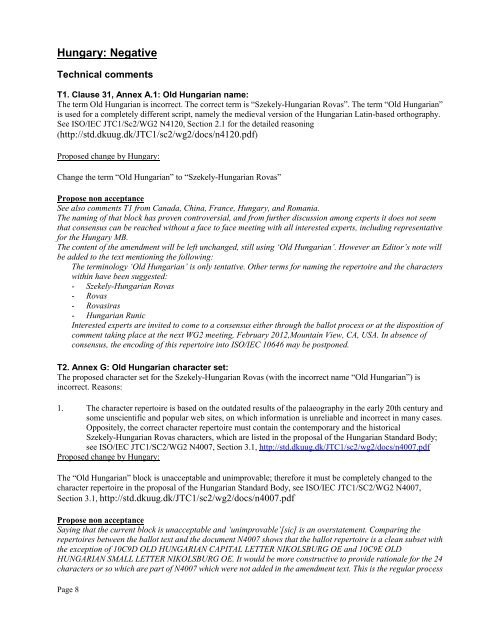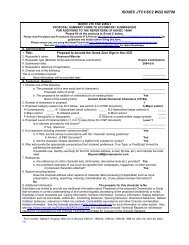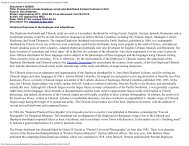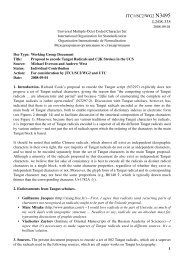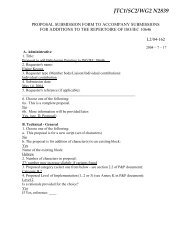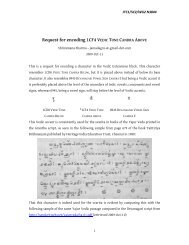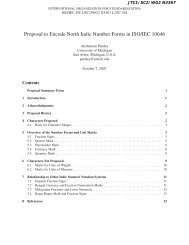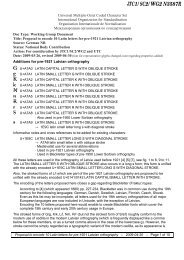ISO/IEC JTC1/SC2/WG2 N 4161R - DKUUG standardizing
ISO/IEC JTC1/SC2/WG2 N 4161R - DKUUG standardizing
ISO/IEC JTC1/SC2/WG2 N 4161R - DKUUG standardizing
Create successful ePaper yourself
Turn your PDF publications into a flip-book with our unique Google optimized e-Paper software.
Hungary: Negative<br />
Technical comments<br />
T1. Clause 31, Annex A.1: Old Hungarian name:<br />
The term Old Hungarian is incorrect. The correct term is “Szekely-Hungarian Rovas”. The term “Old Hungarian”<br />
is used for a completely different script, namely the medieval version of the Hungarian Latin-based orthography.<br />
See <strong>ISO</strong>/<strong>IEC</strong> <strong>JTC1</strong>/Sc2/<strong>WG2</strong> N4120, Section 2.1 for the detailed reasoning<br />
(http://std.dkuug.dk/<strong>JTC1</strong>/sc2/wg2/docs/n4120.pdf)<br />
Proposed change by Hungary:<br />
Change the term “Old Hungarian” to “Szekely-Hungarian Rovas”<br />
Propose non acceptance<br />
See also comments T1 from Canada, China, France, Hungary, and Romania.<br />
The naming of that block has proven controversial, and from further discussion among experts it does not seem<br />
that consensus can be reached without a face to face meeting with all interested experts, including representative<br />
for the Hungary MB.<br />
The content of the amendment will be left unchanged, still using ‘Old Hungarian’. However an Editor’s note will<br />
be added to the text mentioning the following:<br />
The terminology ‘Old Hungarian’ is only tentative. Other terms for naming the repertoire and the characters<br />
within have been suggested:<br />
- Szekely-Hungarian Rovas<br />
- Rovas<br />
- Rovasiras<br />
- Hungarian Runic<br />
Interested experts are invited to come to a consensus either through the ballot process or at the disposition of<br />
comment taking place at the next <strong>WG2</strong> meeting, February 2012,Mountain View, CA, USA. In absence of<br />
consensus, the encoding of this repertoire into <strong>ISO</strong>/<strong>IEC</strong> 10646 may be postponed.<br />
T2. Annex G: Old Hungarian character set:<br />
The proposed character set for the Szekely-Hungarian Rovas (with the incorrect name “Old Hungarian”) is<br />
incorrect. Reasons:<br />
1. The character repertoire is based on the outdated results of the palaeography in the early 20th century and<br />
some unscientific and popular web sites, on which information is unreliable and incorrect in many cases.<br />
Oppositely, the correct character repertoire must contain the contemporary and the historical<br />
Szekely-Hungarian Rovas characters, which are listed in the proposal of the Hungarian Standard Body;<br />
see <strong>ISO</strong>/<strong>IEC</strong> <strong>JTC1</strong>/<strong>SC2</strong>/<strong>WG2</strong> N4007, Section 3.1, http://std.dkuug.dk/<strong>JTC1</strong>/sc2/wg2/docs/n4007.pdf<br />
Proposed change by Hungary:<br />
The “Old Hungarian” block is unacceptable and unimprovable; therefore it must be completely changed to the<br />
character repertoire in the proposal of the Hungarian Standard Body, see <strong>ISO</strong>/<strong>IEC</strong> <strong>JTC1</strong>/<strong>SC2</strong>/<strong>WG2</strong> N4007,<br />
Section 3.1, http://std.dkuug.dk/<strong>JTC1</strong>/sc2/wg2/docs/n4007.pdf<br />
Propose non acceptance<br />
Saying that the current block is unacceptable and ‘unimprovable’[sic] is an overstatement. Comparing the<br />
repertoires between the ballot text and the document N4007 shows that the ballot repertoire is a clean subset with<br />
the exception of 10C9D OLD HUNGARIAN CAPITAL LETTER NIKOLSBURG OE and 10C9E OLD<br />
HUNGARIAN SMALL LETTER NIKOLSBURG OE. It would be more constructive to provide rationale for the 24<br />
characters or so which are part of N4007 which were not added in the amendment text. This is the regular process<br />
Page 8


